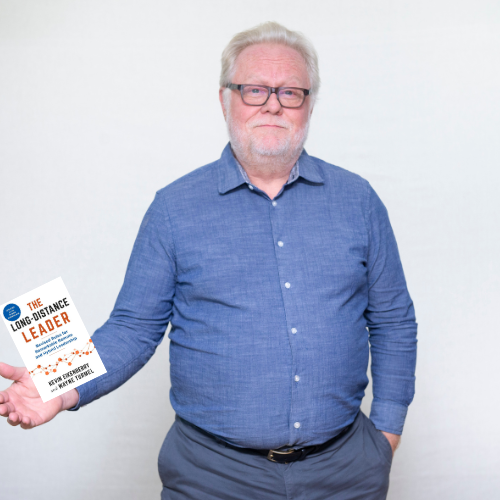WLP366 The Multiple Challenges of "Hybrid"
A special episode to celebrate the launch of the revised edition of The Long-Distance Leader, written by Kevin Eikenberry and Wayne Turmel, who returns to the show with another conversation that made Pilar laugh plenty of times.
The conversation takes a critical look at the “hybrid” workplace - is it a compromise, a hostage negotiation? Or is the problem that we’re all transitioning to a new era of knowledge work, and are uncomfortable with uncertainty? Wayne also covers the role of trust, building a culture fit for hybrid and proximity bias.
We’ve changed voices for today. Here’s a summary of Wayne’s contribution, in first person.
In 2018, we released The Long Distance Leader, a book that, in retrospect, was ahead of its time. Back then, remote work was steadily growing—around 25% to 30% each year—but no one could have predicted how COVID-19 would transform the workplace landscape overnight. The pandemic pushed us into uncharted territory, forcing businesses and employees alike to reconsider how and where work gets done.
Fast forward to today, and the workplace has changed dramatically. Not only have more people experienced remote work, but our technology and the way we use it have also evolved. For example, Zoom was virtually unknown in 2018, and what we now know as Microsoft Teams was still Skype for Business.
These changes have prompted us to update the book to reflect the new realities of hybrid work—a term that has become a buzzword but is often misunderstood. Hybrid work is frequently seen as a compromise rather than the innovative blend it should be. In biology, a hybrid is a new, distinct entity created from two different elements, like a mule—a creature that is neither a donkey nor a horse but something entirely new. This is how hybrid work should function: as a novel approach to achieving goals, not merely a stopgap between remote and in-office work.
Unfortunately, what many call hybrid work today feels more like a "hostage negotiation." Companies want employees back in the office, but after tasting the freedom of remote work, many employees are reluctant to return. As a result, we see compromises like the "three days in the office" rule, which can be less effective than intended. We believe hybrid work should be about more than just where the work gets done—it should also consider when it gets done. This requires smart decisions about synchronous and asynchronous work.
Wayne Turmel and The Long=Distance Leader
The current shift in the workplace is perhaps the most significant since the 1920s, when the 40-hour workweek became the standard. Just as that era redefined what it meant to work, today’s changes are shaking up long-held beliefs about office culture, work-life balance, and the very nature of employment. COVID-19 has forced us to confront these questions, and the answers are still unfolding.
As we navigate this uncertain time, it's crucial for both employers and employees to focus on what they can control. For employers, this means clearly defining what business they are in and how to serve customers profitably. For employees, it's about understanding their responsibilities and finding ways to meet them without sacrificing their well-being.
The updated edition of The Long Distance Leader incorporates lessons from our other work, such as The Long Distance Team, and emphasises the three pillars of culture: communication, collaboration, and cohesion. These "three Cs" are essential for defining what your work environment should look like, whether your team is hybrid, fully remote, or something in between.
Communication isn’t just about choosing between Teams or Slack; it's about the style and frequency of interactions. Collaboration is about understanding workflows, responsibilities, and the need for synchronous or asynchronous work. Cohesion is about how often and in what ways your team comes together, whether in small groups or larger gatherings.
One of the biggest challenges right now is the assumption that we’ll get it right on the first try. The reality is that the return to office life has been anything but smooth. Many companies are finding that their initial plans aren't working as expected, and they’re having to make adjustments on the fly.
Interestingly, younger employees—those early in their careers—are often the most eager to return to the office, seeking mentorship and collaboration. On the other hand, middle managers and mid-career professionals, who have more responsibilities outside of work, prefer the flexibility of remote work. These differing needs highlight the importance of continually reassessing our assumptions as we move forward.
One issue that has become more pronounced in hybrid settings is proximity bias, where leaders may unconsciously favor those they see in person more frequently. This can lead to the formation of cliques and a perception among remote workers that they are less valued or have fewer opportunities for advancement. Addressing this requires intentionality from leaders to ensure that all team members, regardless of location, are included and supported.
We’ve put together a booklet of 25 tips from the updated version. If you’re considering whether the new book is right for you, feel free to reach out to me on LinkedIn or via email, and I’ll gladly send you a copy.”
Don’t forget to also check out the podcast The Long-Distance Worklife, which Wayne hosts with Marisa!
Find out more about the book here:
kevineikenberry.com/products/the-long-distance-leader
Listen to the Long-Distance Worklife podcast and Check out Wayne’s website too:
wayneturmel.com
And if you’d like to hear more from the authors, listen to Wayne in episode 238 or hear from Kevin Eikenberry in episode 181.
If you like the podcast, you'll love our monthly round-up of inspirational content and ideas:
(AND right now you’ll get our brilliant new guide to leading through visible teamwork when you subscribe!)


